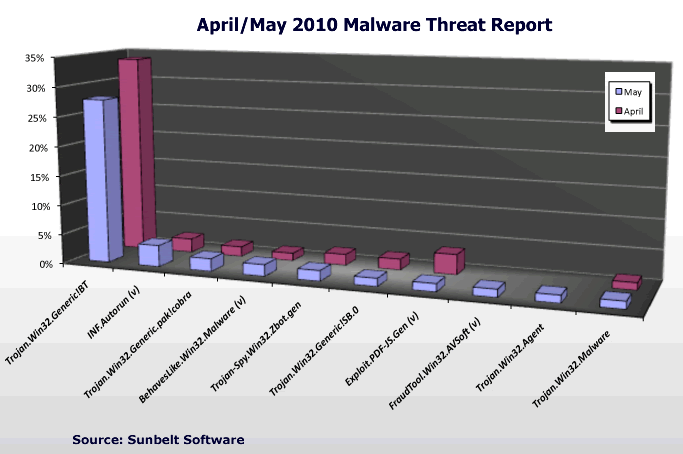Top 10 Malware Threats – May, 2010
Security software company, Sunbelt Software, in its monthly malware threat report, today announced the top 10 most prevalent malware threats detected in May 2010.
Eight of the 10 detections for the month of May had also been among the April top 10, with Trojan.Win32.Generic!BT still holding the number-one spot with 27.8 percent of detections, down from 33.7 percent in April.
Detections of “INF.Autorun (v)” showed a significant change in May, spiking by more than 55 percent, from 2.34% of overall detections in April to 3.63% in May. INF.Autorun (v) had an almost 40 percent increase in from March to April as well.
Two new malware detections in top 10 list were number eight, FraudTool.Win32.AVSoft (v) at 1.32 percent, and number nine, Trojan.Win32.Agent at 1.28 percent. FraudTool.Win32.SecurityTool (v) is a VIPRE detection for malware that installs SecurityTool rogue antivirus software and Trojan.Win32.Agent is a Trojan downloader that downloads a wide variety of malcode.
Sunbelt Software Research Center Manager Tom Kelchner said, “The list of ThreatNet top-10 detections in May did not change significantly from the previous month – with a continued high volume of Trojan downloaders. However, the level of generic detections has steadily increased over the past few months, highlighting the importance of behavioral testing via a “sandbox” method to stop malicious applications without individual signature updates. This is a good strategy for stopping zero-day malicious code, or previously unknown malware, which is being generated by the bad guys with more frequency.”
The top 10 Most Prevalent Malware Threats for May are:
| 1. Trojan.Win32.Generic!BT | 27.79% |
| 2. INF.Autorun (v) | 3.63% |
| 3. Trojan.Win32.Generic.pak!cobra | 2.14% |
| 4. BehavesLike.Win32.Malware (v) | 1.95% |
| 5. Trojan-Spy.Win32.Zbot.gen | 1.78% |
| 6. Trojan.Win32.Generic!SB.0 | 1.35% |
| 7. Exploit.PDF-JS.Gen (v) | 1.34% |
| 8. FraudTool.Win32.AVSoft (v) | 1.32% |
| 9. Trojan.Win32.Agent | 1.28% |
| 10. Trojan.Win32.Malware | 1.25% |

The top 10 results represent the number of times a particular malware infection detected and reported back to ThreatNet, Sunbelt’s community of opt-in users. These threats are classified as moderate to severe based on method of installation among other criteria established by SunbeltLabs.
Related Reading: Top 10 Malware Threats for April, 2010
















